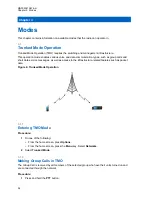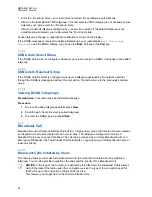
3.3.10
Communication through Gateways
Gateway provides connectivity between radios operating in Direct Mode Operation (DMO) and the
TETRA network, so that the DMO radios can communicate with the Trunked Mode Operation (TMO)
radios.
Figure 7: Communication through Gateways
DMO
TMO
TMO
When the radio connects to a gateway, it plays a tone, displays the
Gateway available
message,
and shows an appropriate icon. When the radio loses connection with the gateway, it plays a tone,
displays the
Gateway not available
message, and the gateway icon is blinking.
3.3.11
Gateway and Repeater Synchronization
To communicate using gateways or repeaters, the radio requires synchronization with a gateway or a
repeater.
A gateway or a repeater sends presence signals to radios. If a radio receives presence signals, it stays
synchronized with the gateway or the repeater which sends the signals. If a radio fails to receive a
presence signal it does not immediately lose synchronization. The radio waits for another successful
presence for a time defined by your service provider. This function ensures that communications are
not dropped due to temporary reception issues.
If a gateway or a repeater is unavailable or the radio is not synchronized with a gateway or a repeater,
depending on the setup configured by your service provider, the following scenarios apply:
• The radio falls back to Direct Mode Operation (DMO).
• After pressing the
PTT
button, a prompt appears warning that the second press overrides the
gateway or repeater operation mode.
• No direct DMO communications are permitted.
In the second scenario, while the radio receives individual calls and group calls, and replying to
individual calls is possible, replying to group calls is not possible.
MN002041A01-AH
Chapter 3: Modes
63
















































